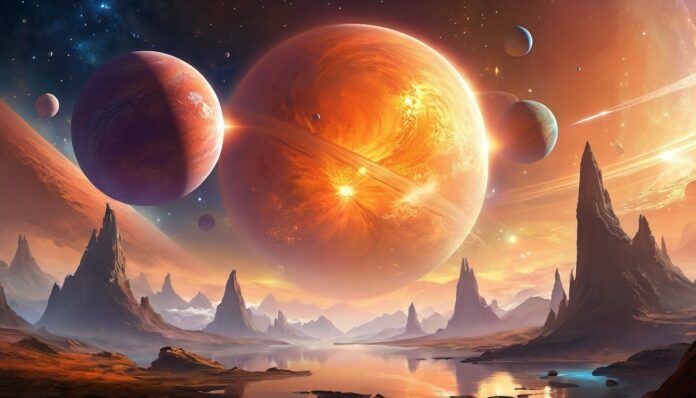An exoplanet, or extrasolar planet, is a planet that orbits a star outside our solar system. These planets vary widely in size, composition, and distance from their parent stars. Here are some key points about exoplanets:
Definition and Discovery
- Definition: Exoplanets are planets located outside our solar system, orbiting stars other than the Sun.
- Discovery Methods: Various techniques are used to discover exoplanets, including the transit method (observing a planet as it passes in front of its star, causing a dip in brightness) and the radial velocity method (detecting the wobble of a star caused by the gravitational pull of an orbiting planet).
Types of Exoplanets
- Gas Giants: Similar to Jupiter and Saturn in our solar system, these are large planets composed mostly of hydrogen and helium.
- Rocky Planets: Similar to Earth and Mars, these planets have solid surfaces and are composed mostly of rock and metal.
- Super-Earths: Planets with a mass larger than Earth’s but smaller than that of Neptune, which can be rocky, gaseous, or a mix of both.
- Hot Jupiters: Gas giants that orbit very close to their parent stars, resulting in extremely high surface temperatures.
Habitable Zone
- Definition: The habitable zone, also known as the “Goldilocks zone,” is the region around a star where conditions might be right for liquid water to exist on a planet’s surface.
- Importance: Planets within this zone are considered prime candidates in the search for extraterrestrial life, as liquid water is essential for life as we know it.
Notable Discoveries
- Kepler-186f: The first Earth-sized exoplanet found within the habitable zone of its star, discovered by NASA’s Kepler Space Telescope.
- Proxima Centauri b: An exoplanet orbiting Proxima Centauri, the closest star to the Sun, located about 4.24 light-years away.
Research and Exploration
- Space Telescopes: Instruments like the Kepler Space Telescope and the Transiting Exoplanet Survey Satellite (TESS) have greatly expanded our knowledge of exoplanets.
- Future Missions: Upcoming missions, such as the James Webb Space Telescope, aim to study exoplanet atmospheres and search for signs of habitability or life.
So, here are the most interesting facts about exoplanets.
- An exoplanet is any planet located in a different stellar system.
- As of today, scientists have discovered over 4100 exoplanets.
- The first exoplanets were discovered in the late 1980s.
- The oldest known exoplanet is “Kapteyn b,” located 13 light-years from Earth.
- The exoplanet “Kepler-78b” has almost the same size as our planet but is 90 times closer to its star, resulting in surface temperatures ranging from +1500 to 3000 degrees Celsius.
- Did you know that there are 9 exoplanets orbiting the star “HD 10180”? It’s possible that there are even more.
- The “hottest” of the discovered exoplanets is “WASP-33b” – 3200 degrees Celsius.
- The exoplanet closest to Earth is “Alpha Centauri b.”
- It’s interesting that the total number of exoplanets in the Milky Way galaxy is estimated to be 100 billion!
- On the exoplanet “HD 189733b,” wind speeds exceed 8500 meters per second.
- “WASP-17b” is the first discovered planet orbiting its star in the opposite direction of the star’s rotation.
- “OGLE-TR-56” is the first star whose planet was discovered using the transit method, based on observations of the planet’s movement against the background of the star.
